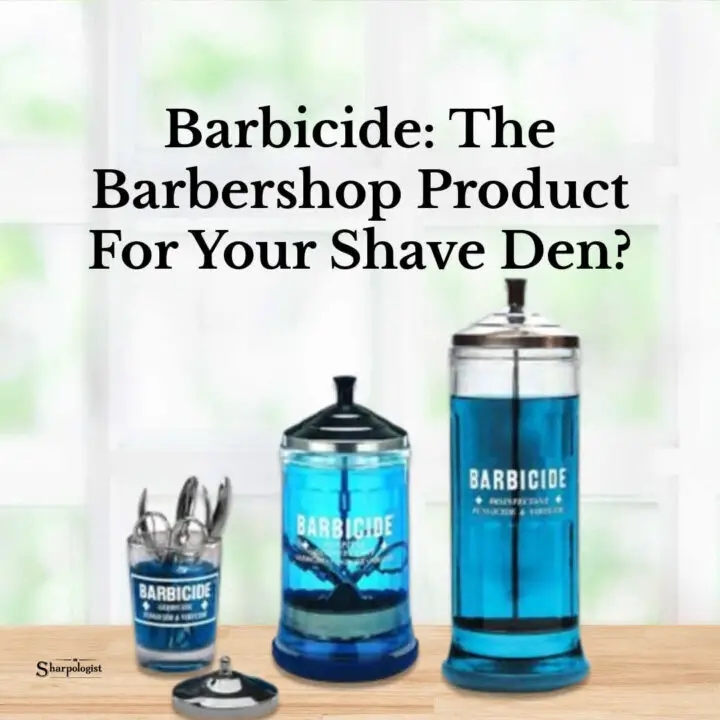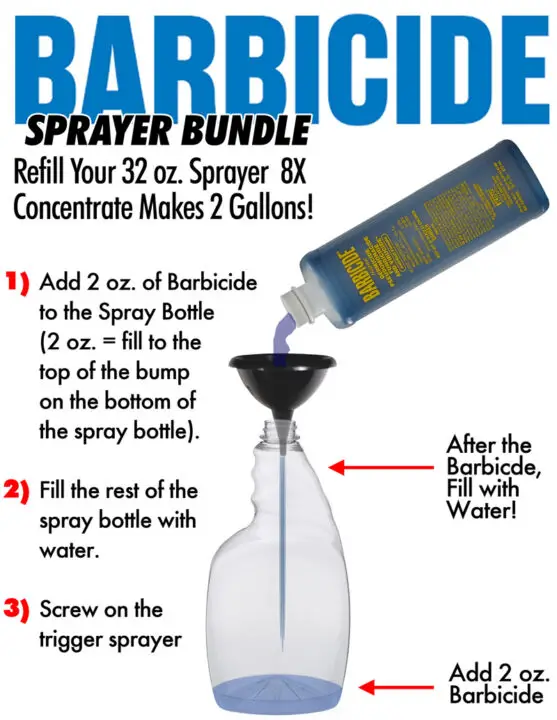[Updated February, 2023] Sharpologist readers are all about the nostalgia of the barbershop experience in their home. Barbicide is a classic barbershop disinfecting solution that may have a place in your shave den. Barbicide kills skin-infecting bacteria and fungi.
Barbicide: What is it?
Created in the 1940s by Maurice King, Barbicide is used to disinfect grooming tools such as combs, hair cutting shears, and instruments made from carbon steel. It is also effective in cleaning and sanitizing surfaces.
Barbicide is marketed heavily around the United States to barbshops and salons, and is a combination fungicide, germicide, pseudomonads and a viricide that is effective against HIV-1, Hepatitis B and Hepatitis C. Barbicide has been registered by the United States Environmental Protection Agency as an approved product since it was first introduced to the market.
Barbicide was also used by barbershops in the US as a legal requirement before 2018 reforms eliminated this practice.
How Barbicide works
Barbicide is a ~5% solution of Alkyl dimethyl benzyl ammonium chloride which, when mixed with water, creates a powerful sanitizer by binding to the proteins on the surface of bacteria and viruses, breaking them down and killing them.
For this reason, it is often used as a disinfectant for tools and surfaces. It can also be sprayed or poured into sinks or drains to help kill any bacteria that may be lurking there.
It is important to follow all safety precautions when using this product, and always read and follow the manufacturer’s instructions.
Precautions And Side Effects when using Barbicide
It is important to take precautions when using Barbicide, as it can be harmful if ingested or come into contact with skin.
Do not drink or eat while working with Barbicide. If it comes into contact with skin, rinse thoroughly with water. If swallowed, seek medical attention immediately.
It is also reported to have adverse effects when it comes into contact with human skin. Some people have experienced redness, burning, and swelling after coming into contact with the chemical. In some cases, Barbicide has even caused blistering and rashes.
If you are allergic to any of the ingredients in Barbicide, do not use the product under any circumstances.
From the Barbicide website:
“BARBICIDE® must be changed daily in all containers used to submerge combs, brushes, shears, implements—that is all tubs, glass or plastic jars. It should also be changed whenever contaminated or diluted incorrectly.”
What are the benefits of Barbicide?
Barbicide is a disinfectant that is used to clean and disinfect hair styling tools and other hard surfaces. It is effective at killing bacteria, viruses, and fungus, and it is safe to use on both metal and plastic tools. Barbicide also leaves a protective coating on the tools that helps to prevent the build-up of bacteria and corrosion.
There are reasons to use Barbicide in your shave den. Some of the top benefits include:
– Barbicide is an effective disinfectant that can kill a wide range of bacteria and viruses, including HIV, MRSA, and HPV.
– It is popular and widely used by hospitals, clinics, veterinary offices, and other medical professionals and institutions.
– Barbicide is easy to use and comes in a variety of formulations that can be tailored to your specific needs.
– It has a long shelf life and is economical to use.
How To Use Barbicide In Your Shave Den
Barbicide is a disinfectant that is specifically made to clean barber tools and other hard surfaces. It comes in a liquid form and should be mixed with water before use. It is used in a spray, dip, or immersion form.
Barbicide Mixing Ratio
Generally, Barbicide is diluted into cold water at a 1:16 ratio (e.g. one ounce of Barbicide into 16 ounces of water–preferably distilled water).
Usage: Spray vs. Immersion
The best way to disinfect clippers, scissors, and razors is by immersing them for 10 minutes in the Barbicide solution. However, not all tools can be immersed in the liquid, so if you cannot submerge your tool then you should spray it with Barbicide. The general rule of thumb is “If you can immerse it, do so; if you cannot, spray it.”
The first step in using Barbicide is to clean all hard, non-porous surfaces with soap and water. After that, CaviCide can be used as an intermediate level surface disinfectant on non-porous surfaces such as glass or plastic. It’s effective against TB, HBV, HCV, viruses (hydrophilic and lipophilic), bacteria (including MRSA and VRE) and fungi.
When using Barbicide, it is important to adhere to the contact time listed on the label. This will ensure that all germs and bacteria are killed and avoid damage to the tool.
Barbicide should not be used on porous materials such as wax pots, because it can damage them.
From the Barbicide website:
What is the difference between “sanitize”, “clean”, “disinfect”, “sterilize” and “hygiene”? They all get used together, and I am confused.
“Sanitize”, “clean” and “hygiene” all refer to the broad category that means you have done something to remove visible debris. Examples of this would be wiping down a counter, holding something under running water, using soap and water on an item or using a cleaning solution like Ship-Shape®. Disinfecting is the killing of most microbial life that can lead to infection in humans—such as Influenza, Staphylococcus, HIV/AIDS, Herpes, Salmonella and Hepatitis. This step is done following cleaning and requires the use of a disinfectant such as BARBICIDE®, BARBICIDE® TB or BARBICIDE® Wipes. Sterilization is the killing of all microbial life and requires an autoclave and is mainly used in healthcare.
Disposal
Diluted Barbicide liquid is suitable for disposal in a sink or drain.
My Barbicide Product Review
Even before COVID I regularly used Barbicide on razors that I received during pass-arounds, before selling or PIF’ing-out razors from my collection, and after buying the occasional vintage razor:
– Clean with soap and water, a diluted vinegar solution, or an ultrasonic jewelry cleaner (depending on what kind of shape the item was in);
– Immerse in Barbicide and soak for no more than ten minutes;
– Rinse thoroughly, dry.
I never experienced any problems with Barbicide damaging a razor, though I have read a couple of horror stories on the shave forums. However almost invariably a longer-than-recommended soak was involved. Soaking something in Barbicide overnight is a recipe for disaster.
After COVID hit and before it was well-understood I also used Barbicde to disinfect flat, dry surfaces around our home as a precaution, as Mrs. Mantic59 is immune-comprimised.
I also use it on combs, brushes, scissors, etc.
Where Can You Buy Barbicide?
[Note: Amazon and geni.us links are affiliate.]
Barbicide concentrate can be purchased from a variety of retailers, both online and offline. Some popular online retailers include the Barbicide website, Amazon and Walmart; while some popular offline retailers include Sally Beauty and Ulta. Click/tap here for some examples.
The Barbicide Glass Jar
Part of the “mystique” of the barbershop experience are the visuals, including implements like the jars that hold the Barbicide diluted solution. There are three sizes: a 4 Fl Oz Manicure Table Jar, a 21 Fl Oz Midsize jar, and the 37 Fl Oz Large jar.
Barbicide Wipes
Barbicide wipes are EPA-Registered bactericidal, virucidal, fungicidal & tuberculocidal with a 2-minute contact time. They’re particularly convenient for wiping down counters, cabinets, and other hard, flat surfaces. Barbicide Wipes can be disposed in standard trash receptacles.
Barbicide Alternatives
Cavicide is a disinfectant and cleaner in one, popular in medical facilities because of its quick efficacy against harmful viruses and bacteria. It may be used on most sturdy and non porous surfaces.
Mar-v-cide is probably Barbicide’s primary competitor. It has similar ingredients and virus killing capabilities but in a different concentration.
Conclusion
Barbicide is a powerful disinfectant that can be used to clean and disinfect your shave den. It is important to use Barbicide correctly in order to achieve the desired results.



